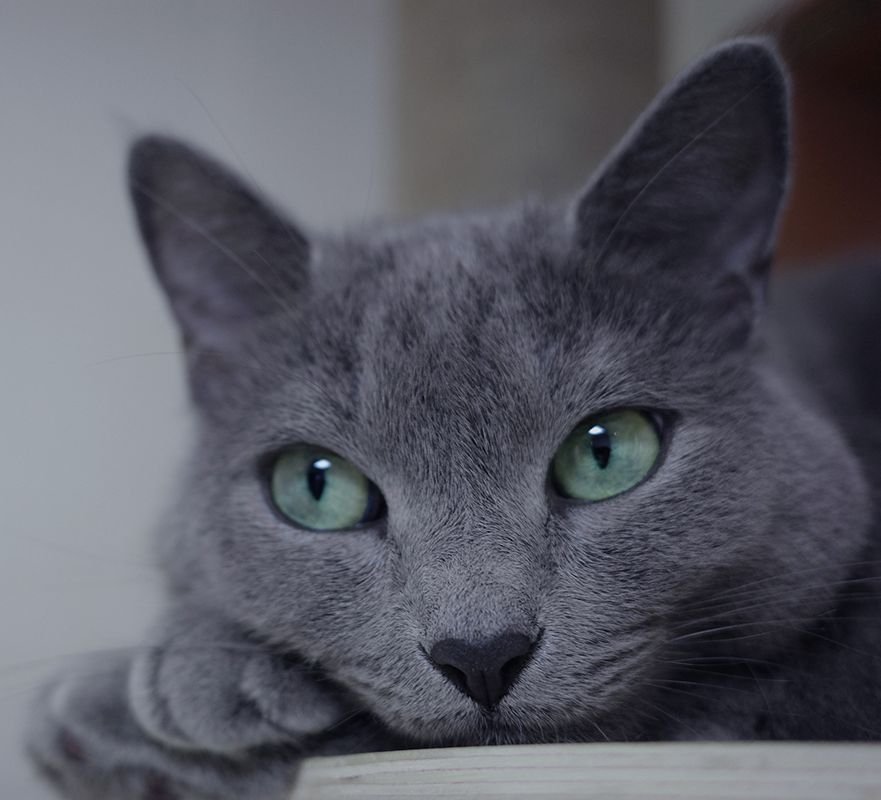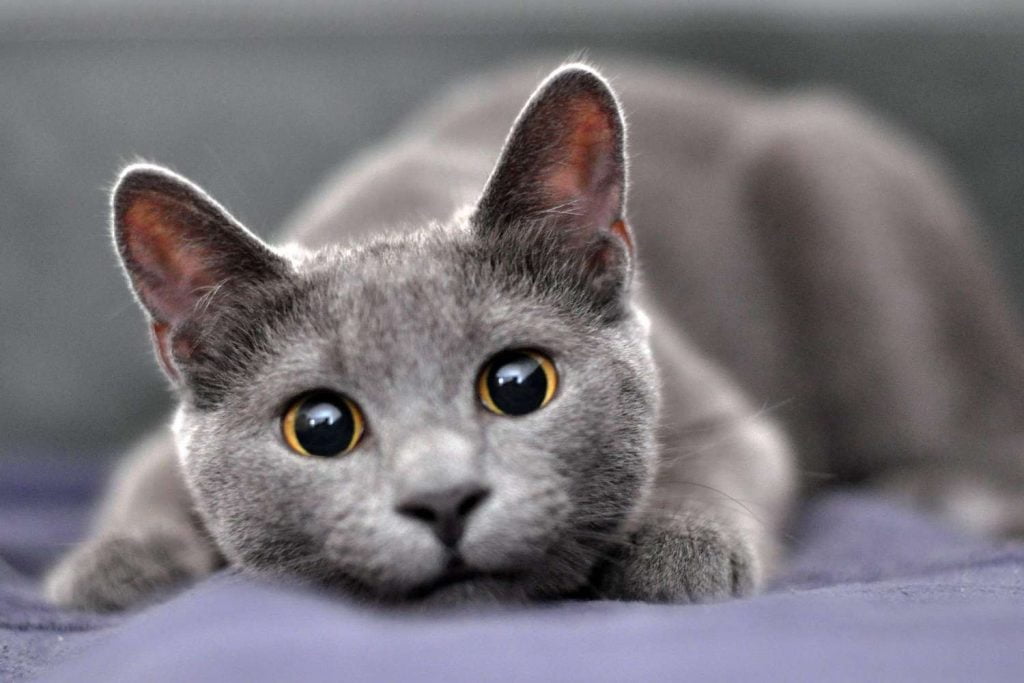
The Russian Blue, or “Blue Russian” as it’s informally known, is a natural breed that’s believed to have originated in the Russian port city of Arkhangelsk (“Archangel”). It is also sometimes called “Archangel Blue”.
The hallmark characteristic of the Russian Blue is its short, dense blue-grey double coat, and bright, emerald green eyes. The undercoat is very soft and the guard hairs are tipped with silver.
This breed is known to be very intelligent, has an excellent memory, and loves to play games.
It is also believed that the Russian Blue is hypoallergenic, or better tolerated by people with allergies.
Buying a Blue Angel Cat
If you were intrigued by our short description of this breed and are toying with the idea of taking one home, you’ll probably want to know what the Blue Russian cat price is, right?
First of all, you’ll need to find an honest and legitimate breeder. There are many who would sell mixed-breed cats as Russian Blues while charging a high markup.
Most of these kittens were probably not raised under satisfactory living conditions and may have any number of physical disabilities, genetic mutations or diseases which the breeder has not disclosed. Choosing a good breeder is, therefore, absolutely the first step on your journey to owning a Russian Blue.
We’ve done some research on your behalf and located a number of good catteries that sell Russian Blues for fair prices. Russian Blues Cattery is a home-based breeder which currently sells kittens for $500 each.
They also have upcoming litters if you can’t commit to a purchase right now and might be interested in the future. All kittens are fully vaccinated, microchipped, have health certificates, and are regularly dewormed and treated for fleas/ticks.
Purchases come with a free Royal Canin voucher, toy, and blanket. Pedigree and registration information is available.
Furthermore, kittens are pre-trained to use litter boxes and scratching posts.
Royal Blues is another cattery located on a farm in Ohio and it sells its cats for up to as much as $2,500.
The large difference in price comes from the fact that it is registered with The International Cat Association (TICA) and its stock comes from European champion bloodlines. This means that cats in its ancestry have won competitions and thus, these are of show-quality.
Besides, it provides a lot of extras which increase the value of the purchase. Kittens take at least two vet exams within 4 months, receive all age-appropriate vaccinations, and are spayed/neutered.
The pets are microchipped, enrolled in a 30-day pet insurance policy (with Trupanion), and come with a welcome kit which includes a TICA slip, kitten carrier, health guarantee, health records, toys, blankets, and samples of their food which is Royal Canin Mother & Baby Cat kibble and Weruva wet canned food.
A delivery service is available for $450 for buyers that live out of state. A pet flight nanny will personally hand-deliver the kitten to your local airport.
Alternately, if you don’t need a show cat, adopting a Russian Blue is an excellent idea. The Friends For Life Animal Rescue in Washington has available kittens to rescue for $110 for one or two for $200.
All cats have been spayed/neutered and tested for feline leukemia and feline AIDS. Some cats are also provided with rabies vaccinations.
A microchip and registration are also included automatically.
PetCurious also lists plenty of Russian Blue kittens for adoption in New Jersey, New York, Connecticut, Pennsylvania, and Maryland, among many other states. Adoption fees range from $150 to $300 depending on each specific shelter and the animal that is being rescued.
Additional Expenses

Aside from the initial costs, taking proper care of a Russian Blue will entail shouldering many additional expenses such as its daily food, medical bills, registration information, and more.
Many cities throughout the United States require cats to be rabies vaccinated and licensed. For example, a cat license in Hampton, Virginia may be purchased at the Treasurer’s Office and costs $4 for a neutered animal and $10 for an unneutered animal.
Licenses expire each year and must be renewed every January 1st. Alternatively, a lifetime license may be purchased which costs $10 for neutered cats and $20 for unneutered cats.
Being aware of nearby vets and their respective service fees will reduce bill shock if you run into a medical emergency. This is especially important if you have opted to not purchase pet insurance.
Costs vary depending on which clinic you go to. Here’s an example of veterinary services coming from the Spay Neuter Clinic to give you an idea of the prices. It currently has offices in Arizona, Delaware, Louisiana, and Pennsylvania:
- Cat Spay – $51
- Cat Neuter – $33
- Pain Treatment – $15
- Leukemia Vaccination – $15
- Rabies Vaccination – $21
- FVRCP – $14
- Leukemia Test – $27
- FIV / Leukemia Test – $34
- Microchip + Registration – $33
Consult your breeder regarding the vaccination status of your new kitten and its upcoming schedule.
Don’t forget to invest in a good type of kibble to keep your Russian Blue strong, healthy, and in its ideal weight. Cats need a high-quality and high-protein diet with fewer grains and fewer plant by-products.
Both wet and dry food have something useful to offer your kitten. A recommended kibble for you to start off with is Iams Proactive Health Dry Cat Food which costs around $30 for a 22-lb bag.
As your archangel blue grows up, you’ll no doubt want to start bringing it along on family outings, camping trips, and during vacations. If you want to bring your kitty on a plane, there are a few items that it’ll need.
A pet passport is for traveling internationally and a health certificate will need to be procured from a licensed veterinarian and presented to the airline to prove that your cat is current on vaccinations. According to the USDA, health certificates will cost from $121 to $173.
Once you get all the required paperwork together, preparing your Russian Blue for a comfy ride is the last step. If one wasn’t provided by your breeder, investing in a quality cat carrier will make your life easier on the plane and will allow you to bring your kitty in the cabin.
You’ll want to buy this product in advance so that you have time to let your cat become familiarized with it.
The OxGord Fleece Bed Bag by Paws & Pals is recommended because it conforms to nearly all the standards put forth by airline companies. Its dimensions are 19”x10”x13” inches and it will comfortably fit a cat of up to 7 pounds in weight. It costs around $27.
Caring for Your Russian Blue Kitten
Now that you’ve got all the little details out of the way, it’s time to make your new baby feel more at home in its new environment. The Russian Blue is a naturally social cat and won’t have problems with getting comfortable within the first week.
Here is a list of tips to help you:
- Use Feliway Spray to help a new kitten get acquainted with its travel carrier.
- A Feliway Diffuser can be used at home and will effectively provide the same effects as the spray.
- Provide overnight access to food and water in case your pet gets hungry.
- Cat litter trays should be in a safe, but easily accessible location.
- Form a quick bond with your new kitten by cuddling and playing with it right away.
- Beyond the treatment given by the breeder, de-worming should be given once a month.
- Russian Blues should be neutered before they turn 6 months old.

How can I adopt a full-grown Russian Blue from a shelter?